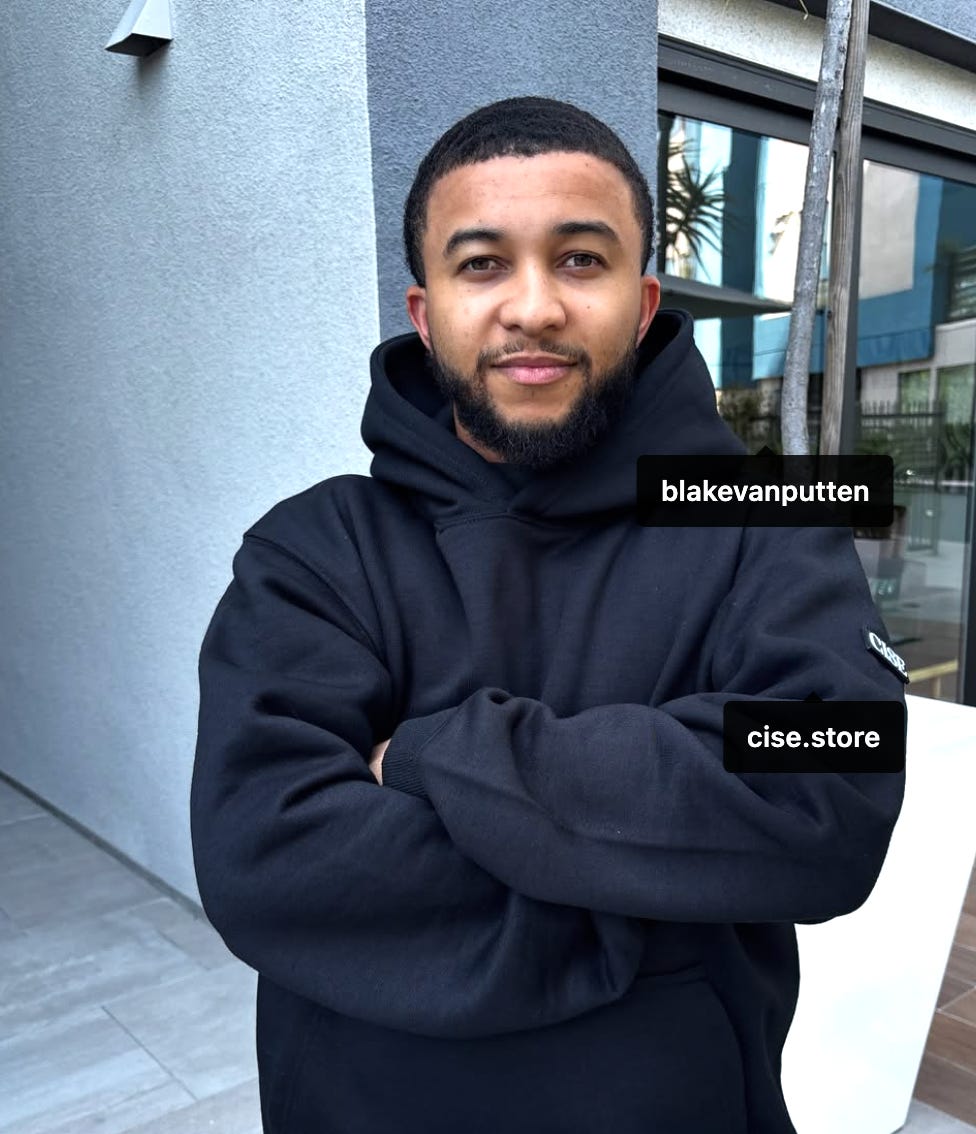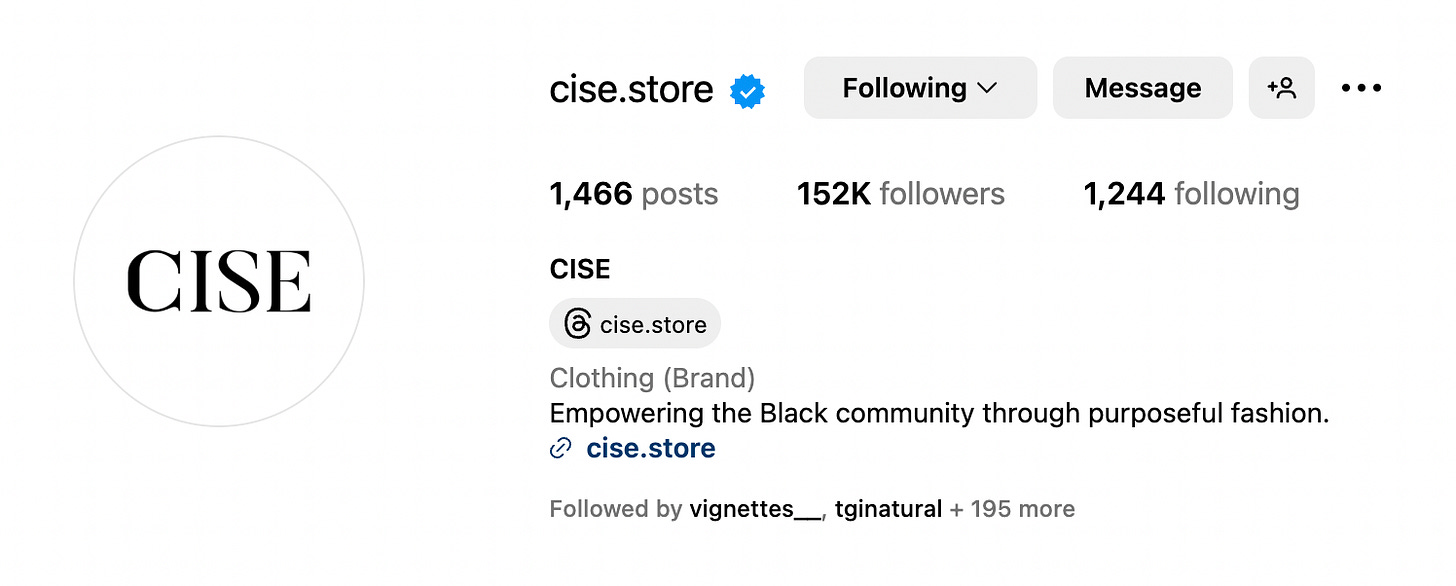Building an Authentic Brand Voice When Your Message Matters
Building an Authentic Brand Voice When Your Message Matters
When your brand carries a message bigger than your products, your voice becomes your most valuable asset. An authentic brand voice isn't just about consistency in typography or color schemes. It's about communicating values in a way that feels genuine to both you and your audience. At CISE, building this voice meant stripping away marketing jargon and speaking directly from my experience as a Black founder with something important to say.
Finding your authentic voice starts with knowing exactly why you're doing what you're doing. This isn't about crafting a clever mission statement for your website. It's about having clarity on the change you want to create in the world and why it matters to you personally. I started CISE because I needed to express frustration and hope during a tumultuous time, not because I spotted a market gap for message-driven fashion. That personal necessity shaped everything about how we communicate, making our voice genuine because it comes from lived experience rather than market research.
Your brand voice needs to reflect who you actually are, not who you think customers want you to be. Early on, I faced pressure to sound more "professional" or "elevated" in our communications. But something felt off whenever I tried to fit into those expectations. When I finally decided to communicate in my natural voice, the same way I'd explain our mission to a friend, our engagement skyrocketed. People respond to authenticity, especially when you're asking them to support a cause beyond just buying a product. They need to feel the human behind the message.
Finding Your True North: Values That Guide Your Voice
Before you can develop a consistent brand voice, you need absolute clarity on your non-negotiable values. At CISE, we spent significant time defining our core beliefs: community empowerment, transparency, and quality craftsmanship. These values became our compass for every communication decision, from social media captions to product descriptions to customer service responses. When you're unsure about the right tone or message, returning to these foundational values provides direction.
Your values should be specific enough to be actionable but broad enough to apply across different situations. For instance, our value of transparency means we openly share our production costs, challenges, and even mistakes. This value shapes our voice to be candid and straightforward, avoiding corporate-speak or glossing over difficulties. Your values should similarly translate into concrete communication principles that team members can apply consistently across touchpoints.
The most powerful brand voices come from values that are personally meaningful to the founder but also resonate with the target community. The sweet spot is where your authentic beliefs overlap with what matters to your audience. For CISE, focusing on community empowerment works because it's genuinely important to me and deeply relevant to our customers who want their purchases to create positive change. This alignment creates a voice that feels both authentic to us and meaningful to those we're trying to reach.
When Brand Voice Meets Activism: Walking the Fine Line
Mixing commerce with social activism requires careful navigation. Your brand voice needs to convey conviction without sounding preachy, passion without exploitation, urgency without fear-mongering. We've learned to strike this balance by focusing on solutions rather than just highlighting problems. Our messaging emphasizes what's possible when communities come together, not just what's wrong with the world, creating a voice that mobilizes rather than paralyzes.
Timing and context awareness must become integral parts of your brand voice strategy. During moments of acute social crisis, we adjust our tone to show appropriate reverence and sensitivity. This might mean pausing promotional content, shifting focus to community resources, or changing how we frame our products' relevance. A strong brand voice isn't static; it adapts to social context while maintaining its core character. This responsiveness demonstrates genuine commitment to your cause beyond marketing opportunism.
The most challenging aspect of combining activism with commerce is addressing criticism that you're profiting from social issues. Your brand voice must proactively tackle this concern through radical transparency. We openly discuss how proceeds support community initiatives, where our materials come from, and how we set our prices. This level of openness builds trust by acknowledging the inherent tension in mission-driven business and showing how you're thoughtfully addressing it. Your voice should never shy away from the hard questions that conscious consumers rightfully ask.
Community Over Algorithm: Building Relationships That Matter
In 2020, we faced an unexpected challenge when paid advertisements were banned during the election season. With our primary marketing channel suddenly unavailable, we had to find another way to spread our message. This forced pivot became our greatest blessing. Instead of optimizing for algorithms, we started focusing exclusively on building genuine community connections through direct engagement. We replied personally to comments, hosted virtual conversations, and spotlighted community members using our products in meaningful ways.
This community-first approach completely transformed our brand voice. Instead of broadcasting messages outward, we started having conversations. Our tone became more collaborative and responsive, shaped by the ongoing dialogue with our community. We learned to ask questions, not just make statements. We started featuring customer stories alongside our own. The result was a brand voice that felt less like corporate marketing and more like being part of a movement where everyone has something valuable to contribute.
The organic growth we experienced through community building proved more valuable than any paid strategy. People don't share advertisements with their friends, but they enthusiastically share brands that make them feel seen, heard, and valued. By investing in relationship-building rather than reach metrics, we developed brand advocates who amplified our voice far beyond what our budget could have achieved. This approach requires patience, as community connections don't generate overnight results, but it creates a foundation of loyalty that algorithms can never match.
Consistency Without Rigidity: Keeping Your Voice Fresh
Building a recognizable brand voice requires consistency, but avoiding staleness demands evolution. At CISE, we maintain core elements of our voice across all platforms: directness, optimism tempered with realism, and community-centeredness. These foundations stay constant while allowing flexibility in how they're expressed across different contexts. Our Instagram voice has more immediacy and visual support, while our email communications take a more reflective, detailed approach, but both unmistakably sound like CISE.
Regular voice audits help prevent drift while encouraging intentional evolution. Every few months, we review our communications across channels, asking whether they still reflect our values and resonate with our community. Sometimes we notice we've slipped into industry jargon or started sounding too formal. Other times, we realize our voice needs to evolve to address new topics or connect with expanding audience segments. These periodic checks maintain authenticity while allowing growth.
The key to keeping your voice fresh is listening more than you speak. When we actively absorb how our community talks about issues that matter to them, what language resonates, and how conversations are evolving, our own voice naturally stays relevant. This doesn't mean mimicking trending phrases or changing core beliefs, but rather ensuring our established voice stays connected to current conversations. The most authentic brand voices grow organically alongside their communities rather than remaining rigidly fixed to initial formulations.
Finding Words That Work: Language Choices That Connect
The specific words you consistently use or avoid become powerful signals of your brand's values and positioning. At CISE, we deliberately use inclusive language that avoids insider terminology or academic jargon that might create barriers. We say "community" instead of "customers," "create impact" rather than "drive sales," and "join the movement" instead of "buy now." These conscious word choices reflect our belief that fashion activism should be accessible to everyone, not just those with specialized knowledge.
Beyond individual word choices, the structure of your communication reveals your brand's relationship to its audience. We avoid talking down to our community or positioning ourselves as the ultimate authority on social issues. Instead, our sentence structures and message framing invite dialogue, acknowledge complexity, and often include questions that encourage reflection. This approach creates a voice that feels more like a respected friend than a distant brand or preaching activist.
Cultural sensitivity in language requires ongoing education and humility. As a Black-owned brand speaking to diverse audiences about social justice, we're constantly learning how different communities experience language. We've made mistakes, using terms that unintentionally excluded certain groups or framed issues in ways that didn't resonate across different cultural contexts. When this happens, acknowledging the misstep and adjusting becomes part of your voice evolution. Authenticity isn't about perfect language; it's about genuine commitment to growth and responsiveness.
The Visual Voice: When Design Amplifies Message
Your brand voice extends beyond words to visual elements that communicate just as powerfully. At CISE, our typography choices deliberately balance strength with approachability, using bold sans-serif fonts for statements that demand attention while incorporating softer elements for context and explanation. This visual hierarchy reflects our voice's balance between conviction and conversation, making strong declarations while remaining open to dialogue.
Color choices carry significant cultural and emotional weight that must align with your verbal messaging. Our palette centered on black and white creates a foundation of clarity and directness, while strategic use of vibrant accents signals optimism and energy for change. We're intentional about avoiding colors with potentially problematic associations for the communities we serve, recognizing that color perception varies across cultural contexts. Your visual voice should demonstrate the same cultural awareness and intentionality as your written communications.
Photography style dramatically shapes how your audience perceives your brand's authenticity. We prioritize images showing real people engaged with our products in everyday settings over highly stylized fashion photography. We showcase diverse body types, skin tones, and personal styles to reflect our community accurately. When featuring activists wearing our pieces, we capture them in their natural environments rather than artificial studio setups. These visual choices reinforce our verbal commitment to representation and reality, creating a cohesive voice across all sensory dimensions.
When to Speak Up and When to Listen: Timing Your Voice
Not every social conversation requires your brand's participation. Strategic silence sometimes speaks louder than immediate commentary, especially on complex issues where listening and learning should precede public statements. We've developed an internal framework for determining when CISE should add its voice to broader social discussions. Does this directly connect to our mission? Do we have something meaningful to contribute beyond generic support? Is our community looking to us for guidance or response? These questions help us participate thoughtfully rather than reactively.
When tragedies or controversies occur, timing becomes especially critical. Rushing to comment can come across as exploitative or uninformed, while complete silence might signal indifference. We've learned that an immediate acknowledgment of awareness, followed by a more thoughtful response after proper consideration, often strikes the right balance. This approach demonstrates respect for the issue's complexity while still showing our community that we're engaged and responsive.
The pace of your communication also forms part of your brand voice. We intentionally resist the pressure for constant content creation, preferring fewer, more meaningful messages over a stream of reactive posts. This measured approach signals thoughtfulness and intention, qualities central to our brand identity. It also creates space for community voices to be heard between our messages, reinforcing our commitment to dialogue rather than monologue. Your communication rhythm should reflect your values just as much as the content itself does.
Navigating Criticism: How Your Response Defines Your Brand
How you respond to criticism ultimately defines your brand voice more than your carefully crafted statements. At CISE, we've faced various critiques, from questions about our production practices to challenges about whether fashion can meaningfully address social issues. Rather than becoming defensive or dismissive, we've incorporated direct engagement with criticism into our voice. We publicly address concerns, explain our reasoning, and acknowledge limitations, turning potential brand threats into demonstrations of our transparency value.
Different types of criticism require different response approaches, all consistent with your core voice. For factual inaccuracies, we provide clear corrections without condescension. For misalignments with our values or practices, we explain our position while respecting different perspectives. For legitimate shortcomings, we acknowledge the gap between our ideals and current reality, sharing plans for improvement. This nuanced approach to criticism demonstrates confidence in your mission while maintaining the humility essential for authentic connection.
The most powerful aspect of engaging criticism is demonstrating how feedback shapes your growth. When community members raised concerns about size inclusivity in our early collections, we didn't just acknowledge the criticism but showed how it directly influenced our expanded sizing. This "closed feedback loop" communicates that your brand voice includes listening, not just speaking. It transforms critique from a threat to be managed into a valuable input that strengthens your relationship with your community and enhances your brand's authenticity.
Finding Your Voice Across Platforms: Adaptation Without Dilution
Each social platform has its own cultural norms and communication patterns, requiring strategic adaptation of your core voice. On Instagram, our voice embraces visual storytelling and concise, impactful statements that complement our imagery. On Twitter, we adopt a more conversational, responsive tone that engages with current events while maintaining our distinct perspective. On TikTok, we incorporate more personality and behind-the-scenes authenticity. These adaptations maintain our fundamental voice while respecting each platform's unique environment.
Your website and email communications offer opportunities for deeper voice development beyond the constraints of social media. In these owned channels, we expand on the thinking behind our collections, share more detailed impact reports, and develop more nuanced positions on complex issues. This multi-tiered approach creates a voice ecosystem where casual followers can connect with our core messages through social media, while those seeking deeper engagement find substance on our website and in our emails.
Maintaining voice consistency across channels despite necessary adaptations requires a clear framework accessible to everyone creating content. We've developed a simple voice guide that identifies our core traits (direct, hopeful, inclusive, educational without being preachy) alongside examples of how these manifest differently across platforms. This practical tool helps ensure that whether someone encounters CISE on Instagram, through email, or on our website, they experience a cohesive brand personality despite the different formats and contexts.
From Founder's Voice to Brand Voice: Building a Lasting Identity
When your brand begins as a personal mission, transitioning from founder's voice to sustainable brand voice requires careful planning. In CISE's early days, every word came directly from me, reflecting my personal reactions to social events and my specific communication style. As we've grown, I've had to intentionally identify which elements of my natural voice are essential to the brand and which aspects others can authentically adopt when creating content on CISE's behalf.
Documentation becomes essential as your team expands beyond yourself. We've created resources that capture not just what we say but why we say it that way, providing context behind our voice choices. New team members don't just receive style guidelines but understand the values and history informing our distinct approach. This deeper understanding allows them to make appropriate voice decisions in new situations rather than just mimicking past communications, ensuring our voice can evolve organically while maintaining its essence.
Building a brand voice that can outlast your daily involvement means regularly bringing in other perspectives while maintaining core principles. I've gradually incorporated more team input into our voice development, recognizing that a truly sustainable brand identity must be collectively owned rather than founder-dependent. This collaborative approach strengthens our voice by incorporating diverse perspectives while ensuring continuity through shared commitment to our foundational values. The goal is creating a voice distinctive enough to be recognizable but flexible enough to thrive beyond any individual's contribution.
When Values Get Tested: Maintaining Authenticity Under Pressure
Every mission-driven brand eventually faces situations that test whether its voice truly reflects its claimed values. For CISE, these moments have included partnership opportunities with significant financial benefits but questionable alignment with our mission, pressure to moderate our messaging during sensitive social periods, and temptation to follow trends that would boost engagement but dilute our focus. How you navigate these pressure points reveals whether your brand voice is a marketing strategy or an authentic expression of your values.
Growth often brings the greatest challenges to voice authenticity. As our audience expanded beyond our initial community, we faced pressure to soften certain messages to appeal to broader markets. We've had to continually ask: Would changing our communication to reach more people ultimately undermine the very reason people connected with us in the first place? This ongoing tension requires regular recommitment to your foundational purpose and careful consideration of which adaptations enhance your mission versus which compromises would fundamentally alter it.
The most authentic brand voices maintain integrity especially when it's difficult. When major retailers expressed interest in carrying our products but requested that we remove certain message elements or "tone down" aspects of our communication to fit their customer base, we had to make hard choices. Sometimes we found acceptable middle ground; other times we walked away from significant opportunities. These decisions, though financially challenging, ultimately strengthened our brand by demonstrating genuine commitment to our values beyond what's convenient or profitable. Your community notices and responds to this consistency under pressure more than to any perfectly crafted message.
Finding Your Brand's Unique Tone: The Art of Distinctive Communication
Between overly corporate blandness and performative edginess lies a vast territory for developing a genuinely distinctive tone. At CISE, we've cultivated a voice that balances seriousness about important issues with hopeful energy for positive change. We discuss challenging social realities without cynicism and celebrate progress without toxic positivity. This nuanced approach creates a distinctive emotional signature that people recognize across our communications, something that feels uniquely CISE rather than generic activism or standard brand messaging.
Your sentence structure, paragraph length, and rhythm contribute significantly to your brand's voice fingerprint. We tend toward direct, concise statements when making key points, followed by more relaxed elaboration that invites deeper consideration. We use questions to engage rather than just declare. We balance statistics with stories, pragmatism with aspiration. These structural patterns create a recognizable flow that makes our content identifiably ours, even without our logo attached. Analyzing your natural communication patterns can reveal similar distinctive elements worth intentionally incorporating into your brand voice.
Developing a truly distinctive voice means having the confidence to break certain conventions when it serves your message. Standard marketing advice often promotes universally appealing, inoffensive communication that risks saying nothing meaningful. We've learned that expressing clear positions, even knowing they won't resonate with everyone, creates stronger connections with those who share our values. This willingness to be distinctively yourself rather than generically palatable ultimately creates a more memorable and authentic brand presence that stands out in an increasingly crowded social consciousness marketplace.
Measuring Voice Impact: Beyond Engagement Metrics
Traditional engagement metrics provide limited insight into whether your brand voice is truly connecting in meaningful ways. While we track standard indicators like comments, shares, and email response rates, we place greater emphasis on qualitative measures that reveal deeper connection. Are people accurately repeating our key messages in their own words? Are they having thoughtful conversations beneath our posts rather than just leaving generic positive comments? Do customer service inquiries reference our values or mission? These indicators reveal whether your voice is creating lasting impact beyond momentary engagement.
Direct community feedback offers the most valuable insight into voice effectiveness. We regularly create opportunities for supporters to tell us what resonates about our communication and where we could improve. Through surveys, focus groups, and informal conversations, we've learned which aspects of our voice create the strongest sense of connection and which sometimes create confusion or distance. This feedback has helped us refine our approach in ways that analytics alone never could, highlighting the importance of direct dialogue in voice development.
The ultimate measure of voice effectiveness is whether it inspires action beyond social media participation. We track how our communications correlate with community involvement in our events, participation in impact initiatives, and contribution to causes we support. We've found that certain voice characteristics, particularly those that balance clear calls to action with genuine respect for individual agency, are most effective at motivating meaningful participation. This action-oriented assessment helps us focus on developing a voice that doesn't just sound good but actually advances our mission in tangible ways.
The Evolution Ahead: Growing Your Voice Without Losing Your Soul
As CISE continues to grow, maintaining voice authenticity while expanding our audience remains our central challenge. We're continuously exploring how to introduce our perspective to new communities without diluting what made our voice meaningful in the first place. This evolution requires bringing more diverse perspectives into our content creation process while ensuring everyone shares a deep understanding of our core mission and values, creating space for fresh expressions while maintaining consistent purpose.
The changing media landscape demands constant adaptation of how we express our voice. Emerging platforms, evolving algorithms, and shifting attention patterns require tactical flexibility while maintaining strategic consistency. Rather than chasing every new platform or trend, we evaluate opportunities based on whether they allow authentic expression of our voice. Sometimes this means being early adopters of formats that align with our communication style; other times it means intentionally avoiding platforms that would require fundamental compromise of how we communicate.
The future of authentic brand voice lies in deeper integration between message and action. As consumers become increasingly sophisticated about identifying performative values, the brands that thrive will be those whose voice genuinely reflects their operational reality. We're working toward ever-greater alignment between what we say and how we function, recognizing that the most powerful voice comes not just from carefully chosen words but from business practices that manifest the same values. This integration represents the next evolution in authentic brand voice, where communication becomes inseparable from action, and where what you say naturally flows from who you are and what you do.











